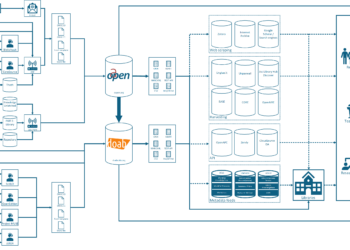Edinburgh University Press (EUP) recently announced the inauguration of its Open Access Fund, which sets aside £250,000 “to publish Open Access editions of 50 research publications by University of Edinburgh staff” over the next five years. The Press’s Chief Executive, Nicola Ramsey, graciously agreed to answer a few questions about this exciting new initiative.

The announcement says that the £250,000 will come from EUP’s cash reserves. This seems like a remarkable level of cash reserve for a university press. Can you share how you managed to accumulate it?
EUP has, since 2010, returned a surplus in most years. This followed a history of break-even/ loss-making, at one point requiring a loan from the University of Edinburgh (which was repaid in 2010, a stellar year for our publishing program, with several major publishing projects coming to fruition). The turnaround wasn’t quick; we had become a wholly-owned subsidiary company of the University of Edinburgh nine years previously, in 2001, granting us a large degree of independence – financially, strategically and editorially – which allowed us to make more commercial publishing decisions. A major strategic review followed, which led to several key decisions:
- We sold Polygon, our trade imprint, to a fellow Edinburgh-based publisher, recognizing that, for benefit of the business as a whole, we needed to focus on academic and scholarly publishing.
- We were overly reliant on the revenue and profit from one major journal, and needed to reduce that reliance (in case of losing that journal to another publisher – which did happen) by building our journals program, and hiring a Head of Journals with commissioning responsibility.
- We decided to narrow the focus of our books program to a smaller number of subject areas, in order to build strength in depth and with the ambition of developing a first-rate reputation within specific fields, rather than spreading ourselves thinly across too many areas. We have invested in the editorial team, including doubling editorial staff in subject areas where we see growth potential – first Literary Studies, and then Islamic & Middle Eastern Studies. The results have been significant: revenues for Literary Studies have grown 75% in 8 years and for IMES 62% in 5 years. The aim is to target future growth following a similar pattern, identifying the next lists where we think additional resource will deliver the best return.
- We closed our co-publications program: to this point we’d been selling North American rights in our best books to US and Canadian presses. This generated very good income, but did nothing for our profile in what we realized should be one of our biggest markets. So we set about building our own brand in America: alongside making sure all EUP books were available in that market under the EUP imprint, we gave our commissioning editors funding support to allow them to travel to the US – primarily to attend the major conferences in their subject areas but also to do some academic calling. This has made a difference to our author profile, where the number of North American authors has grown from roughly 20% of our total in 2011 to more than 30% this year (and that number is closer to 50% in some subject areas such as Islamic & Middle Eastern Studies or Classics & Ancient History).
Subsequent strategic reviews have led us to create a Head of Sales role, and then grow our Sales team (which now includes a Digital Manager). Attention in this time has also turned to our ebook strategy: since 2012 we had made all our books available in both print and digital formats, and then in the period from around 2017 we started a backlist digitization project, recognizing the demand for older titles in a digital format. This was completed in early 2020 which was a tremendous help during the pandemic, where we saw an almost 50% year-on-year increase in ebook sales. We do not have our own platform for our ebooks (we do for our journals) and instead work with several aggregators, who are collectively growing our sales to now account for around 46% of our book revenue.
We have taken the opportunity over the last ten years to invest some of our cash reserve to allow us to grow and consolidate the business, for example with the acquisition of Dundee University Press in 2014, and Avizandum Publishing (a Scots Law publisher) in 2019, and with the purchase of the copyright of some of the journals we publish. However we are now turning our attention to finding ways to use that reserve to further our mission as a university press.
What is the nature of EUP’s relationship with Edinburgh University? Is there an institutional subsidy, either in cash or in kind (such as staffing or office space)?
As noted above, we’re a wholly-owned subsidiary company, which means the University of Edinburgh is our sole shareholder. The relationship is of vital importance to us – we very much see our role as working to support the University’s mission. We are a charity in our own right, so have a Board of Trustees, who are University employees (from the College of Arts, Humanities, and Social Sciences, the Library, and Corporate Services) and they have ultimate responsibility for the business. But the planning and day to day running of EUP is in the hands of the management team. Critically, as a subsidiary company we receive no funding or subsidy from the University (any services we receive are paid for at market rate) and are expected to cover all our costs and return a surplus from our business activities, in order to create financial sustainability and fund the delivery of our mission.
Your press release expresses the hope that “this fund will go some way” toward “finding a sustainable model OA model for our books.” Is it your plan to continue publishing open access (OA) monographs at this level into the indefinite future? If so, what do you anticipate will be the funding source going forward?
One of the key objectives within our current Strategic Plan (2023-27) is to expand our open access offering, to drive discoverability and usage, thereby speaking to our vision to maximize the influence and impact of every EUP publication. Along with other mid-sized university presses publishing in the humanities and social sciences, we face the challenge of a lack of research funding for many of our authors and contributors across books and journals. It is within this context that we have committed ourselves to finding sustainable solutions, participating in a range of open access arrangements; to date we’ve published over 100 OA monographs. Our Open Access Fund is an important part of this picture: it will allow us to publish an additional 10 OA monographs each year, in this case from authors based within the College of Arts & Humanities at the University of Edinburgh, which helps us support the University’s commitments within its Strategy 2030 to the open communication of research findings and making research accessible to society. The fund is in place for five years initially, and we will be adding the revenue from the print sales of these monographs to the fund, in the anticipation that it may become largely self-sustaining over time.
EUP typically publishes 200-250 books per year; during the first year of the new OA program, you will publish “OA editions of 50 research publications.” How will these be selected?
Our publishing program is now somewhat larger – we will be publishing around 300 new books in the coming year. The new OA fund will support 10 books each year, which covers the EUP monographs authored by academics based within the University of Edinburgh. In any year where we have fewer than 10 single-authored monographs under contract from Edinburgh academics, we have a set of criteria in place to allow us to broaden the selection (e.g., to co-authored books where at least one author is based at the University).
And now a more technical accounting question that may be of interest to some of our readers: EUP’s annual report for 2021 includes the following note: “As a result we have, as noted at the start of this report, ended the year with consolidated sales of £4.05m (including rights), a gross profit of 68%, a contribution of 73% and a net result of £316k post interest. This is against a budgeted loss of £275k post interest (and a loss of £127k last year).” When the report says “a net result of £316k post interest” against “a budgeted loss of £275k post interest” – does that mean that EUP’s final net revenue figure for 2021 was £41k? (And what’s the difference between a “loss” and a “budgeted loss”? Do the latter carry forward from year to year?)
This means that in the financial year ending 31 July 2021 we returned a surplus of +£316k, so a positive swing of £591k from the budgeted loss of -£275k (i.e., what we thought our year end position would be when we set our budget in the summer of 2020). We’re not usually quite so far off with our budgeting! It was the result of taking a very cautious approach to spend in that financial year: we were incredibly uncertain about how well the market would rebound after the lockdown in the spring of 2020, and therefore took the decision to reduce our costs as far as possible. We were very fortunate that our sales recovered reasonably quickly, and we ended that year with 10% more revenue than we’d budgeted. Because we retained the cost control throughout the year, this led to that very positive net result. Our financial year ending 31 July 2022 (see https://edinburghuniversitypress.com/about-us/annual-report) saw a surplus of +£270k, which reflected a return to a more normal level of spending as our confidence in the market returned. We are now in a period of investment, which will see less surplus in the next 2-3 years, but which will allow us to build for the future. We are in the fortunate position of being able to fund this investment in the business from the cash reserves that we have built up over the last 10+ years.
Discussion
4 Thoughts on "The Open Access Fund at Edinburgh University Press: An Interview with Nicola Ramsey"
This is a great program from EUP but the budget per title is only GBP 5000, which is considerably less than most cost estimates per title I have seen in the literature and posts.
Thank you Zac. The £5k is intended primarily to cover production costs (e.g. copy editing, typesetting, cover design) rather than overhead.
Congratulations, EUP! I’m so impressed by all of it–the sound, strategic business decisions that the Press has made over the course of decades to get to this point and serve Edinburgh University and the wider scholarly communications ecosystem well, and the new program which comes at a great time. I imagine that it will help the university to better manage the new UKRI open access policy that is coming into play, right? Really well done!
Thanks so much Amy. Yes, we certainly hope our fund will play some part in helping the University ensure compliance with the new UKRI policy, which comes into effect in January 2024.



